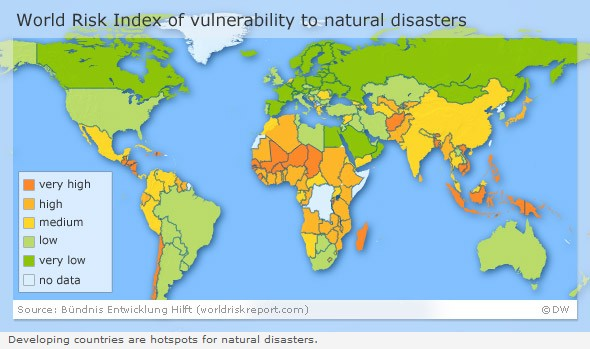Natural disasters, seemingly random events that would not pick or choose its victims, do not, in fact, affect people equally. After looking at 4,605 natural disasters in 141 countries from 1981-2002, researchers have concluded that natural disasters result in a higher mortality rate of women than men. In result, areas that have been affected by a natural disaster have a lessening in the "gender gap" that occurs from the fact that in most regions of the world women have higher life expectancies than men. As natural disasters decrease women's life expectancies more than that of men, the gap decreases.
Researchers also found that the larger the scale of the natural disaster, as measured by loss of life and loss of life per capita, the higher the rate of female mortality. Conversely they found that female mortality is decreased when women's socioeconomic status in affected area is high.
Their proposal is that though natural disasters may be created outside the realm of human control, the majority of human lives lost are a direct result of vulnerabilities created by society. In this case, the term vulnerability means "'the characteristics of a person or group and their situation influencing their capacity to anticipate, cope with, resist and recover from the impact of a natural hazard.'" Women as a group are considered particularly vulnerable in situations of natural disaster for various reasons. In this article, they approach these "socially constructed vulnerabilities" from the aspects of the following:
- biological and psychological differences between the sexes
- social roles, norms and behaviors
- discrimination in access to resources and the breakdown of social order
The immediate implications of biological and psychological differences between the sexes point to the physical limitations of the average female, as they are often slower runners. However, a report from Oxfam in 2005 pointed out that in the 2004 tsunami in Indonesia and Southeast Asia, many of the individuals who were able to self-rescue were taught how to do so. This may throw out the idea of biological factors as inhibiting women's survival in a disaster area and point instead to social factors as the men and boys were favored in the teaching of such survival tools over the women and girls. However, there are real implications for women who are pregnant or nursing.
In many areas of the world, particularly those in poorer regions, women are often confined to strict gender roles that may affect their ability to survive in natural disasters. Women's role as caregivers to children, the elderly, or property, may hinder self-rescue. In other cases, dress code may hinder movement, such as the saris that resulted in drowning many women in Bangladesh during a flood. In other cases, the need of approval from a male family member may stop a woman from traveling to safe grounds on her own.
Many of women's fatalities occur in the aftermath of a disaster when there is a distinct discrimination in access to resources and breakdown of social order. "'The majority of relief efforts are intended for the entire population of a disaster-affected area; however, when they rely on existing structures of resource distribution that reflects the patriarchal structure of society, women are marginalized in the access to relief resources.'" What's more, poor people are the most likely victims of post-disaster fatalities. Throughout much of the world, women are much more likely to be poor than men. The negative economic affects of a disaster are more likely to be irreversible for women as well.
After a large-scale natural disaster that results in the break down of social order, such as post-Katrina New Orleans, or when people flee to refugee camps, women are in an extremely vulnerable position. Domestic and sexual violence increases tremendously in these conditions. The results can be disastrous to populations of women. Rape, especially in the environment of an overcrowded and disease-ridden refugee camp, can cause fatal infections. Complications in maternal care can result in mortality rates "100 times higher than normal".
"In linking spatial patterns of disaster risk to human-generated vulnerability, geography is uniquely positioned to study the impact of natural disasters on socioeconomic systems and groups of people."
The data from this research can inform future policy makers and relief aid organizations in specializing post-disaster response to fit the needs of vulnerable populations, such as women and children.
Eric Neumayer & Thomas Plümper (2007): The Gendered Nature of Natural Disasters: The Impact of
Catastrophic Events on the Gender Gap in Life Expectancy, 1981–2002, Annals of the Association of American Geographers,
97:3, 551-566
http://dx.doi.org/10.1111/j.1467-8306.2007.00563.x


I'm actually quite interested in population, and learning how gender and gender roles may affect that in a disaster situation is quite interesting. However, this article's premise seems to be... pushing it. I can't believe it actually cited that women's Saris in Bangladesh affected whether or not they drown(ed?). Perhaps it is because there's a lack of statistics to support these claims, but I'm assuming the mortality gap isn't as large as this makes it out to be. I think the study would be much more believable and relevant if, instead of natural catastrophes, it was done on war's affect on the gender gap.
ReplyDelete